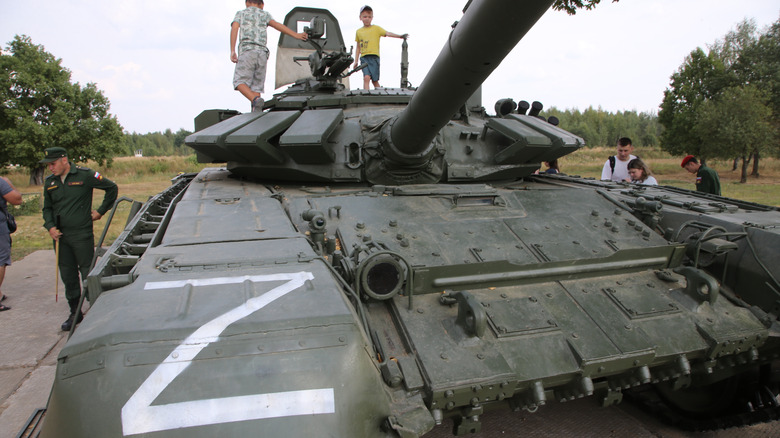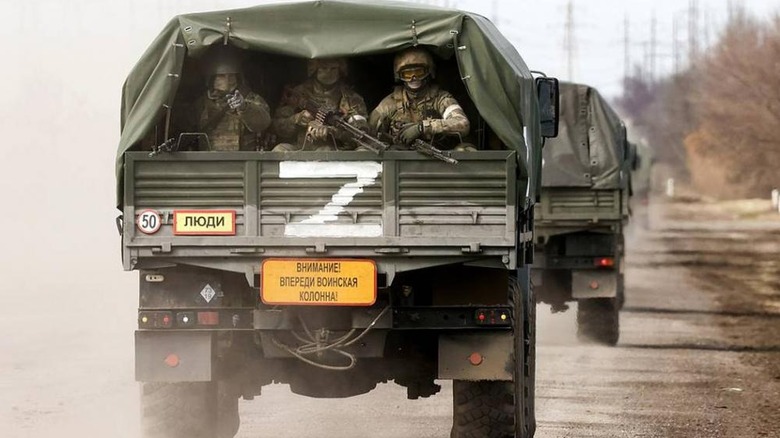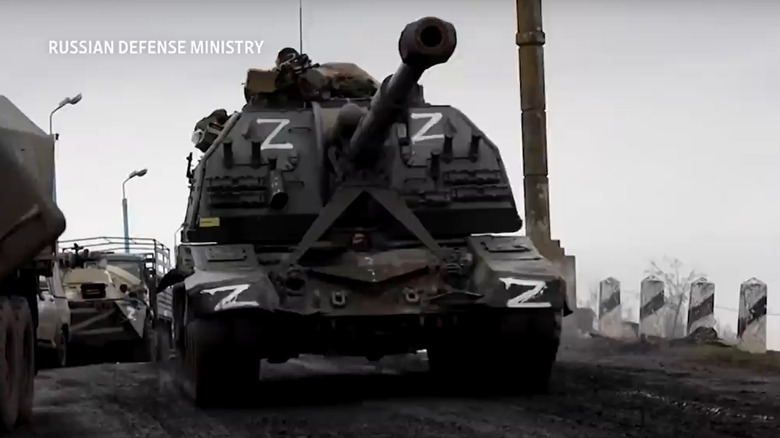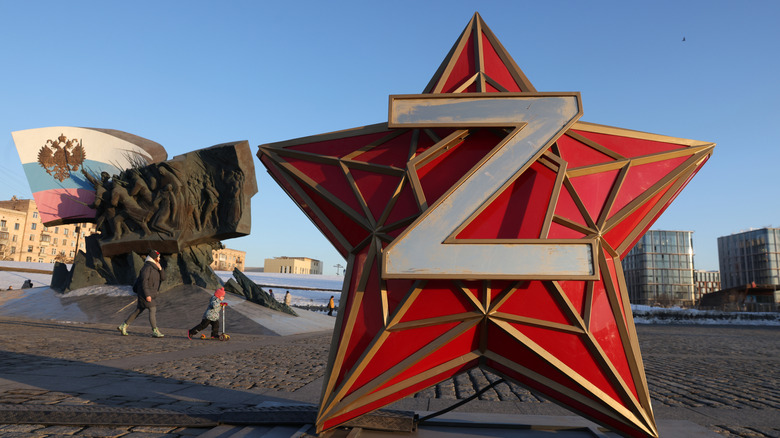Why Do Russian Military Vehicles Have A Z On Them? The Answers Is Complicated
When observers saw the letter Z scrawled onto Russian tanks along the Ukrainian border one week before its 2022 invasion, questions began to swirl about its meaning. Within a few months, the letter transformed into a symbol internationally recognized as supporting the invasion in Ukraine, appearing on billboards, apartment blocks, and even children's hospice wards. Ivan Kuliak, a Russian gymnast, received a one-year ban from the sport for donning the letter beside his Ukrainian competitor at the Gymnastics World Cup in Doha, Qatar in 2022. The Russian government hopped onto the craze soon thereafter, with its state-owned propaganda arm RT selling merchandise with the insignia shortly after the invasion. Even Amazon got caught in the crosshairs of the insignia's rapid rise when it sold merchandise sporting the symbol.
Despite the attention, the meaning of the symbol remains mysterious. Rumored explanations include intricate military maneuvers, tongue-in-cheek satire, and government-staged propaganda. And while several other headlines have risen to the forefront of the Ukraine War, such as the rise of high-tech military tools and Ukraine's use of remote kamikaze cars, the story of Russia's famed Z symbol is a testament to the intricate strategic, political, and media landscapes of modern warfare and propaganda. It is also one that continues to puzzle experts to this day.
Lost in translation
One puzzling aspect of the Z-symbol mystery is the lack of a readily identifiable translation. For one thing, the Latin letter "Z" doesn't resemble its counterpart in Russian Cyrillic, which looks more like the number 3 than any Latin letter. Why Russian military affiliates would paint vehicles with a Latin letter, rather than a Cyrillic one, is only the beginning of the puzzle. Complicating the issue is the quick rise of other Latin letters on Russian military equipment, often framed by geometric shapes like squares and triangles. The letter "V," in particular, had considerable run, appearing alongside the Z insignia in several social media posts by the Russian Ministry of Defense.
When the symbol first began to pop up on Russian military vehicles, several theories appeared. Some observers predicted that the symbol designated where the military units were stationed: Z stood for 'zapad', or West, and V for vostok,' Russian for east. But this theory for the V symbol suffers from the same issue, as the Cyrillic for the V-sound resembles the Latin letter B. Some Kremlin military experts posited that the symbols had an almost satirical bent, predicting that Z and V stood for Volodymyr Zelenskiy and Vladimir Putin, respectively.
For its part, the Russian Ministry of Defense posted on its Instagram account that Z stood for Za pobedu, or "for victory," while V signified sila v pravde meaning "strength in truth." Whether this was the original meaning — or a propaganda spin following the symbol's explosion in popularity — was never confirmed.
Friend or foe?
While the symbol's significance is hotly debated, its operational utility is just as murky. The most popular explanation is that the symbol prevents friendly fire, as Ukrainian and Russian military equipment look quite similar. As such, the Z marking, according to some experts, could be a means of distinguishing friends from targets in the heat of battle. Historically, this is a common practice, one that the U.S. has used in combat zones from D-Day to the Gulf War.
The effectiveness of such a measure is contested, however. Some experts point out that most military aircraft move too quickly to use the markings effectively, putting the utility of these symbols onRussian battle tanks like T-90 into question. However, in an interview with the defense publication Task & Purpose, Air Force Lt. Col. Tyson Wetzel explained that the markings could help prevent fratricide from other weaponry like attack helicopters and artillery. Still, some contest that these Z markings wouldn't be recognizable from large distances, stopping their effectiveness.
Others have hypothesized that it's to coordinate troop movements, indicating any number of strategic details, including identifying special units or communicating end destinations. National security expert Dmitri Alperovitch stated in an X post that the Ukrainian General Staff believed the symbols referred to particular military units, with Z representing Russia's Eastern units and V its naval infantry.
Cultural phenomenon or propaganda stunt?
This uncertainty caused many to suspect that the symbol was a Kremlin publicity stunt. One Russian media expert, Vasily Gatov, went as far as to tell the New York Times that the Z-symbol was "definitely a state-induced meme," suspecting that the Russian state paid propagandists to spread the symbol online. The Russian government has often used symbols like the St. George Ribbon to solicit support for military operations.
A state-coordinated campaign would not only explain its meteoric rise as a nationalist emblem but would also reflect what is a common strategy in Russia's geopolitical toolbox. For instance, investigators in the United Statesand the United Kingdomhave uncovered paid Russian "troll farms" created to spread disinformation on a global scale. The war in Ukraine has been a particular target for these propaganda efforts, utilizing state-sponsored media networks and widespread social media campaigns to drum up support for the invasion at home and abroad.
Whether the symbol's rise was due to Russia's clandestine propaganda machine or not, its fade from the public consciousness in recent years may reflect a variety of broader trends, ranging from shifting public support for the war to the fleeting nature of modern social media trends.
Despite its uncertain origins, Russia's Z insignia is a testament to the role of military symbols in nationalist myth-making and a powerful reminder of the ever-changing public relations landscape of modern warfare.



